Finally! You have your standing desk but wait. Should you wear shoes at a standing desk while using it?
Table of Contents
Although being barefoot while standing at work for an extended amount of time may be pleasant, there are several factors to consider. Going barefoot is probably preferable if you have uncomfortable footwear that provides little support. Still, you also need to consider the surface you are standing on.
Standing without shoes on a firm surface, such as tiles or wood, should provide you with ample support. Still, it could hurt your feet over time, and you could be inclined to sit down more due to these symptoms in your feet, heels, and shins; it might be challenging to reap the benefits of a standing desk.
When we stand for a prolonged period, our bodies can quickly become tired and worn out, which can cause us to stoop and slouch. If your arent comfortable in your shoes, it might get difficult to concentrate on the task at hand and lead to further foot, leg, and back discomfort.
So, what should one do? Wear special shoes or ditch them entirely? Let’s find out!
What Do Experts Say About Wearing Shoes At A Standing Desk?
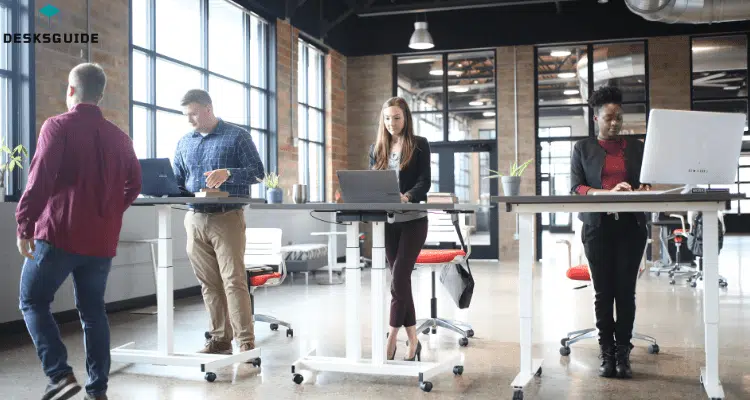
Since standing desks are a relatively new invention and has alot of advantages, but research on them is still ongoing. if you want to check out all the advantages of standing desk at one place, then check this out.
One study suggests that you must wear supportive and comfortable shoes when standing for prolonged periods.
Standing for too long in shoes that don’t provide proper ankle support could increase the risk of heart disease, complicated pregnancies, and poor spinal health.
Standing on Carpet vs. Hard Floor — Which is more comfortable?
It is a common misconception that standing for long periods on a carpeted floor is easier than standing on a hard floor. While the former may be less harsh on your heels, you will get equally sore regardless of standing on a carpeted or hard floor.
In some cases, standing on a hard surface may be easier depending on the material of the floor.
Some carpets are made of multiple not-so-subtle microfibers, which could cause your feet to hurt and form a pattern stencil on the feet. Moreover, the gunk stored in an unclean carpet could lead to infections or extreme dryness around the heel and ball area of your feet.
Is It Better to Stand Barefoot or in Shoes?
While standing all day might be healthier for you, it can also be dangerous if you don’t have the proper footwear or don’t know whether to go barefoot or put on some shoes. Let’s examine the advantages and disadvantages of standing without shoes.
Pros of standing barefoot
Standing barefoot has several health benefits, some of which include:
- More calories are burned standing up.
- Allows proper posture
- Promotes improved balance
- Strengthens the ligaments and muscles of the feet
- Increase in blood flow
- Reduces the risk of heart disease, high cholesterol, and obesity
- Reduces blood sugar levels after eating
- Bolsters and enhances leg muscle tone
- Bolsters the muscles in the back and the core.
Cons of standing barefoot
However, there are certain drawbacks to going barefoot that you could encounter as well:
- In humid situations, the likelihood of developing plantar warts, athlete’s foot, and other conditions connected to the feet might increase.
- Some people may acquire flat feet if they don’t have enough arch support.
- Increases general body exhaustion
- Prolonged standing might worsen back issues and muscular spasms.
- Intensified symptoms of pre-existing foot issues
- Raises the possibility of foot injuries
- It might not be possible in a professional work environment.
Things to Consider Before Standing Barefoot at a Standing Desk
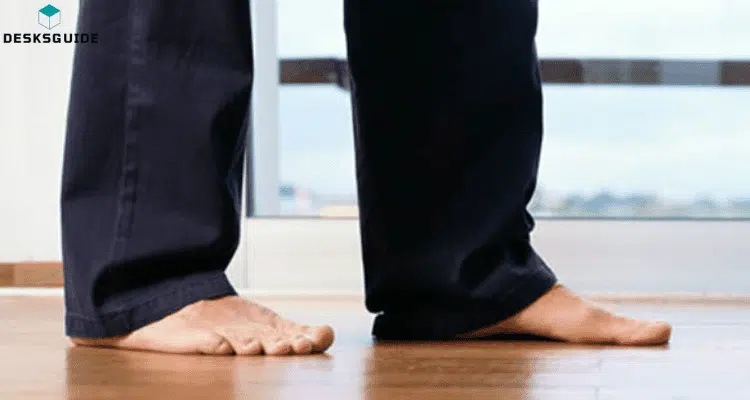
One of the first things you will notice when you start using a standing desk is how sore your feet get when standing for prolonged periods. It takes a while before your body gets used to it.
Here are some things you should consider that can help make the experience easier and more comfortable.
1. How long do you have to stand?
The first concern is the amount of time you may have to stand. Having an idea will help you prepare and plan your day better. You will be able to incorporate a healthy amount of breaks to stretch and move around without falling behind in your tasks.
2. Consider sitting for a portion of the workday
It will take some time before your body gets used to standing for extended periods. Instead of standing for the entire workday, start small and maybe only stand for half and sit for another half. Remember that if a person isn’t used to standing for extended periods, doing so without easing into the practice can harm their feet.
You can also stand for thirty minutes and then sit for the next thirty minutes. This exercise will slowly introduce your body to standing for long and reduce the severity of soreness.
3. Proper weight distribution
When you are not wearing shoes, it may be simpler to feel how your body weight is distributed among your feet. Your entire body weight should be equally distributed, and you shouldn’t be putting more weight on one foot than on another.
However, there is uneven plantar pressure along the whole foot sole. According to research, the ideal distribution of the body’s weight is between 57 and 60 percent on the heels, 40 to 43 percent on the forefoot, and 6 to 8 percent on the arch.
Alternately, knee and hip issues might occur if the weight distribution is incorrect throughout the sole. As a result, the proper weight distribution via the foot will prevent you from locking your knees or tilting your hips forward, which might lead to back pain.
4. Frequent Moving and Stretching
Avoid standing in one place for more than twenty minutes. Keep moving in place and include stretching breaks throughout your workday.
How to Choose the Right Shoes for a Standing Desk?

Here are some tips for choosing the right comfortable and safe shoes for standing desk users.
Adequate Support
They must provide adequate support to your heels and toes without overprotecting them. Exceptional support must be provided to the heel and ball area of the foot. If you can’t gauge exactly which type of shoe you should get, then ask for posture corrective sneakers.
Correct Size
It would be best if you took the style of shoe you’re buying into account when selecting your shoe size because some shoe styles may require you to go up a half size to allow for movement. A shoe size too big or loose on you could lead to tripping and twisting your ankle. However, wearing a size even slightly small could lead to excessive pain, especially around your toenails.
Comfortable Design
Long-standing durations can strain your feet, but shoes with shock absorption can handle it. You may also add in-soles to your shoes to provide more support.
Top 04 Best Shoes for Standing all day at a Standing Desk
Although many shoes are available, we’ve narrowed it down to three trustworthy, well-known, and most comfortable brands frequently recommended when working at a standing desk.
1. Nike Zoom Fly Sneakers
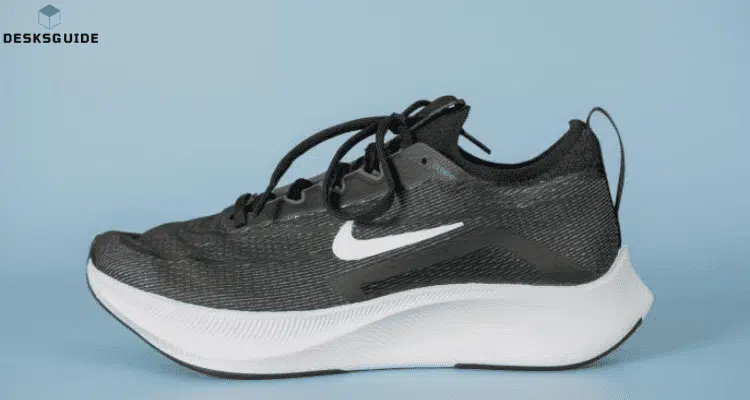
The Nike Zoom Fly 3 has everything of the most recent technology, including ultra-durable Nike React foam and carbon fiber that helps propel you ahead. The Zoom Fly Sneakers can be used as running shoes or as any other of your everyday casual shoes.
2. Brooks Ghost 14
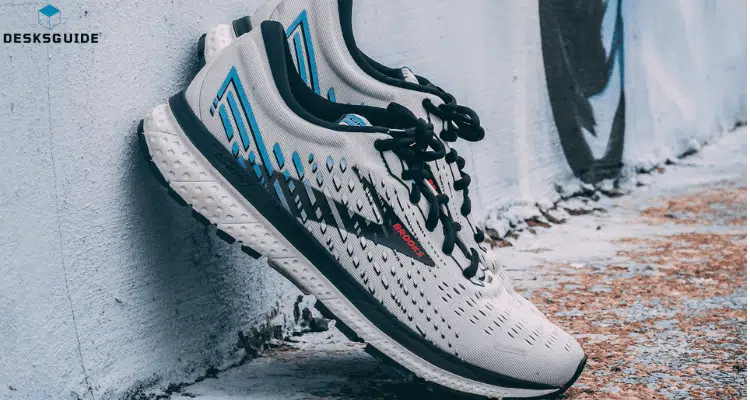
Brooks has developed a cult-like following for its shoes’ more significant support and stability, even if they may not have the exact recalls as Nike. It’s lightweight, flexible, and ideal for people who use standing desks more frequently.
3. New Balance Men’s 608 V5 Casual Comfort Cross Trainer
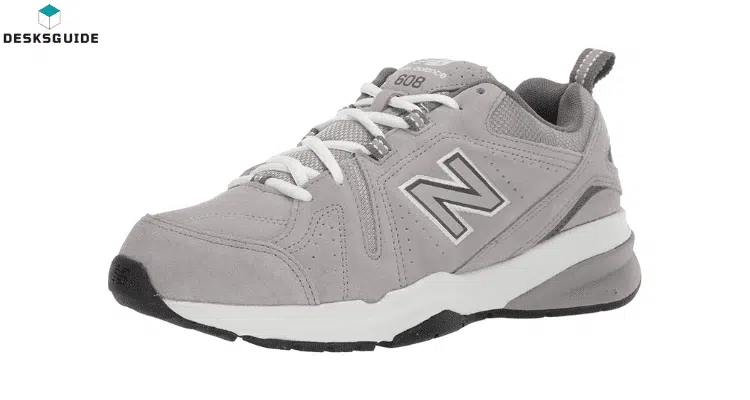
New Balance shoes have everything you’ll need for those hours spent using a standing desk, including well-cushioned bottoms, excellent arch support, strong toe protection, and extra-light EVA outsoles. These make excellent walking shoes that are also great for prolonged standing.
4. Hoka Clifton 8
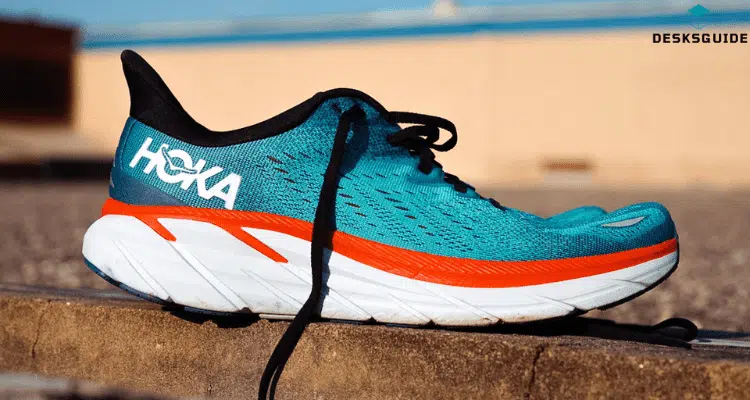
This shoe provides a gentle and light experience to wearing a heavily cushioned shoe. The Clifton 8 is designed with a lighter, more receptive midsole.
Moreover, after numerous tests and reviews, the Hoka Clifton 8s have officially received the American Podiatric Medical Association (APMA) Seal of Acceptance for being beneficial to foot health.
Are There Alternatives to Wearing Shoes?
In contrast to wearing shoes, going barefoot might give you more control over your foot’s position. So, if you don’t prefer wearing shoes for too long, then the following alternatives will prove very useful to you.
1. Bosu Ball For A Standing Desk

The Bosu ball offers several advantages. Standing on a Bosu ball while utilizing a sit-stand desk is an excellent method to maintain your balance, improve your posture, and develop your core muscles.
You can do various exercises using a Bosu ball while at your desk. Doing calf raises or step drills once an hour can prove very beneficial for toning your legs. Bosu balls help improve your core and stabilize muscles, which lowers your chance of falling.
Your enhanced core strength and stability and your internal steadiness provide you with subconscious control to stop falling. You won’t regret including a Bosu ball in your work set-up for a stand-up desk. Just be cautious to start slowly and utilize it correctly to yield the best results.
2. Standing Desk Anti-Fatigue Mats

The anti-fatigue mats are a popular choice among the standing desk community. These mats have ample cushioning, which protects your bare feet from hurting while standing on a hard floor. You can find anti-fatigue mats in various colors and designs to match the aesthetic of your living space.
Moreover, you can also get your hands on an ergonomic anti-fatigue standing mat for extra support. As an alternative, go for a yoga mat with extra foam and use it as a 2-in-1 anti-fatigue mat and a place to stretch between breaks.
If you need more info on the subject, then visit here.
Video Recommendation:
Frequently Asked Questions (FAQs):
Do standing desks cause varicose veins?
The varicose vein is a condition where one’s veins are overfilled with blood, increasing or dilating in size. Standing for extended periods without taking preventive measures can result in extreme pain in your feet and cause the majority of the body’s blood to rush towards your feet. Hence, it can be deduced that using a standing desk for too long could cause varicose veins. Still if you need to read in detail, then check out our this guide on do standing desks cause varicose veins?
Are standing desks good for legs?
Standing for a reasonable amount of time can lead to firm, fit, and toned legs. Hence, it can be said that monitoring standing legs could be good for your legs
How long should you stand at a standing desk?
Researchers have not agreed upon a conclusive answer. Still, it is suggested to divide a two-hour break throughout an eight-hour work day.
What are the five warning signs of a blood clot?
Swelling, excessive pain, bruising, cramping, and warming up of skin are the five warning signs of a blood clot forming in your leg.
Are standing desks good for your back?
Working on a standing desk can be good for your back as it helps improve posture and hence, releases tension from your neck, shoulders, and spine—resulting in reduced back pain.
Final Verdict – Should You Wear Shoes At A Standing Desk?
While standing barefoot has numerous advantages, wearing shoes that provide adequate support might also be beneficial. Ideally, you should be able to tell how healthy your feet are and whether you need extra assistance when standing.
Some individuals with no known medical issues may be able to gain from a brief period of barefoot standing. The best option is to use an adjustable standing desk that will stay lower while you sit and elevate as you stand.
Many medical specialists advise adhering to the 20-2 rule—you should get up and move for about two minutes after every 20 minutes of sitting. A standing desk’s most crucial feature is paying attention to your body. Hence, adjustments should be made if you feel uncomfortable or in pain.
Wearing corrective footwear, however, is your best option if you have any concerns regarding arch support, heel problems, or foot posture orientation. You don’t want to make any existing issues worse by spending extended periods standing.